Text geoms are useful for labeling plots. They can be used by themselves as
scatterplots or in combination with other geoms, for example, for labeling
points or for annotating the height of bars. geom_text() adds only text
to the plot. geom_label() draws a rectangle behind the text, making it
easier to read.
Usage
geom_label(
mapping = NULL,
data = NULL,
stat = "identity",
position = "nudge",
...,
parse = FALSE,
label.padding = unit(0.25, "lines"),
label.r = unit(0.15, "lines"),
label.size = deprecated(),
border.colour = NULL,
border.color = NULL,
text.colour = NULL,
text.color = NULL,
size.unit = "mm",
na.rm = FALSE,
show.legend = NA,
inherit.aes = TRUE
)
geom_text(
mapping = NULL,
data = NULL,
stat = "identity",
position = "nudge",
...,
parse = FALSE,
check_overlap = FALSE,
size.unit = "mm",
na.rm = FALSE,
show.legend = NA,
inherit.aes = TRUE
)Arguments
- mapping
Set of aesthetic mappings created by
aes(). If specified andinherit.aes = TRUE(the default), it is combined with the default mapping at the top level of the plot. You must supplymappingif there is no plot mapping.- data
The data to be displayed in this layer. There are three options:
If
NULL, the default, the data is inherited from the plot data as specified in the call toggplot().A
data.frame, or other object, will override the plot data. All objects will be fortified to produce a data frame. Seefortify()for which variables will be created.A
functionwill be called with a single argument, the plot data. The return value must be adata.frame, and will be used as the layer data. Afunctioncan be created from aformula(e.g.~ head(.x, 10)).- stat
The statistical transformation to use on the data for this layer. When using a
geom_*()function to construct a layer, thestatargument can be used to override the default coupling between geoms and stats. Thestatargument accepts the following:A
Statggproto subclass, for exampleStatCount.A string naming the stat. To give the stat as a string, strip the function name of the
stat_prefix. For example, to usestat_count(), give the stat as"count".For more information and other ways to specify the stat, see the layer stat documentation.
- position
A position adjustment to use on the data for this layer. This can be used in various ways, including to prevent overplotting and improving the display. The
positionargument accepts the following:The result of calling a position function, such as
position_jitter(). This method allows for passing extra arguments to the position.A string naming the position adjustment. To give the position as a string, strip the function name of the
position_prefix. For example, to useposition_jitter(), give the position as"jitter".For more information and other ways to specify the position, see the layer position documentation.
- ...
Other arguments passed on to
layer()'sparamsargument. These arguments broadly fall into one of 4 categories below. Notably, further arguments to thepositionargument, or aesthetics that are required can not be passed through.... Unknown arguments that are not part of the 4 categories below are ignored.Static aesthetics that are not mapped to a scale, but are at a fixed value and apply to the layer as a whole. For example,
colour = "red"orlinewidth = 3. The geom's documentation has an Aesthetics section that lists the available options. The 'required' aesthetics cannot be passed on to theparams. Please note that while passing unmapped aesthetics as vectors is technically possible, the order and required length is not guaranteed to be parallel to the input data.When constructing a layer using a
stat_*()function, the...argument can be used to pass on parameters to thegeompart of the layer. An example of this isstat_density(geom = "area", outline.type = "both"). The geom's documentation lists which parameters it can accept.Inversely, when constructing a layer using a
geom_*()function, the...argument can be used to pass on parameters to thestatpart of the layer. An example of this isgeom_area(stat = "density", adjust = 0.5). The stat's documentation lists which parameters it can accept.The
key_glyphargument oflayer()may also be passed on through.... This can be one of the functions described as key glyphs, to change the display of the layer in the legend.
- parse
If
TRUE, the labels will be parsed into expressions and displayed as described in?plotmath.- label.padding
Amount of padding around label. Defaults to 0.25 lines.
- label.r
Radius of rounded corners. Defaults to 0.15 lines.
- label.size
Replaced by the
linewidthaesthetic. Size of label border, in mm.- border.colour, border.color
Colour of label border. When
NULL(default), thecolouraesthetic determines the colour of the label border.border.coloris an alias forborder.colour.- text.colour, text.color
Colour of the text. When
NULL(default), thecolouraesthetic determines the colour of the text.text.coloris an alias fortext.colour.- size.unit
How the
sizeaesthetic is interpreted: as millimetres ("mm", default), points ("pt"), centimetres ("cm"), inches ("in"), or picas ("pc").- na.rm
If
FALSE, the default, missing values are removed with a warning. IfTRUE, missing values are silently removed.- show.legend
logical. Should this layer be included in the legends?
NA, the default, includes if any aesthetics are mapped.FALSEnever includes, andTRUEalways includes. It can also be a named logical vector to finely select the aesthetics to display. To include legend keys for all levels, even when no data exists, useTRUE. IfNA, all levels are shown in legend, but unobserved levels are omitted.- inherit.aes
If
FALSE, overrides the default aesthetics, rather than combining with them. This is most useful for helper functions that define both data and aesthetics and shouldn't inherit behaviour from the default plot specification, e.g.annotation_borders().- check_overlap
If
TRUE, text that overlaps previous text in the same layer will not be plotted.check_overlaphappens at draw time and in the order of the data. Therefore data should be arranged by the label column before callinggeom_text(). Note that this argument is not supported bygeom_label().
Details
Note that when you resize a plot, text labels stay the same size, even though the size of the plot area changes. This happens because the "width" and "height" of a text element are 0. Obviously, text labels do have height and width, but they are physical units, not data units. For the same reason, stacking and dodging text will not work by default, and axis limits are not automatically expanded to include all text.
geom_text() and geom_label() add labels for each row in the
data, even if coordinates x, y are set to single values in the call
to geom_label() or geom_text().
To add labels at specified points use annotate() with
annotate(geom = "text", ...) or annotate(geom = "label", ...).
To automatically position non-overlapping text labels see the ggrepel package.
geom_label()
Currently geom_label() does not support the check_overlap argument. Also,
it is considerably slower than geom_text(). The fill aesthetic controls
the background colour of the label.
Alignment
You can modify text alignment with the vjust and hjust
aesthetics. These can either be a number between 0 (left/bottom) and
1 (right/top) or a character ("left", "middle", "right", "bottom",
"center", "top"). There are two special alignments: "inward" and
"outward". Inward always aligns text towards the center, and outward
aligns it away from the center.
See also
The text labels section of the online ggplot2 book.
Aesthetics
geom_text() understands the following aesthetics. Required aesthetics are displayed in bold and defaults are displayed for optional aesthetics:
| • | x | |
| • | y | |
| • | label | |
| • | alpha | → NA |
| • | angle | → 0 |
| • | colour | → via theme() |
| • | family | → via theme() |
| • | fontface | → 1 |
| • | group | → inferred |
| • | hjust | → 0.5 |
| • | lineheight | → 1.2 |
| • | size | → via theme() |
| • | vjust | → 0.5 |
Learn more about setting these aesthetics in vignette("ggplot2-specs").
Examples
p <- ggplot(mtcars, aes(wt, mpg, label = rownames(mtcars)))
p + geom_text()
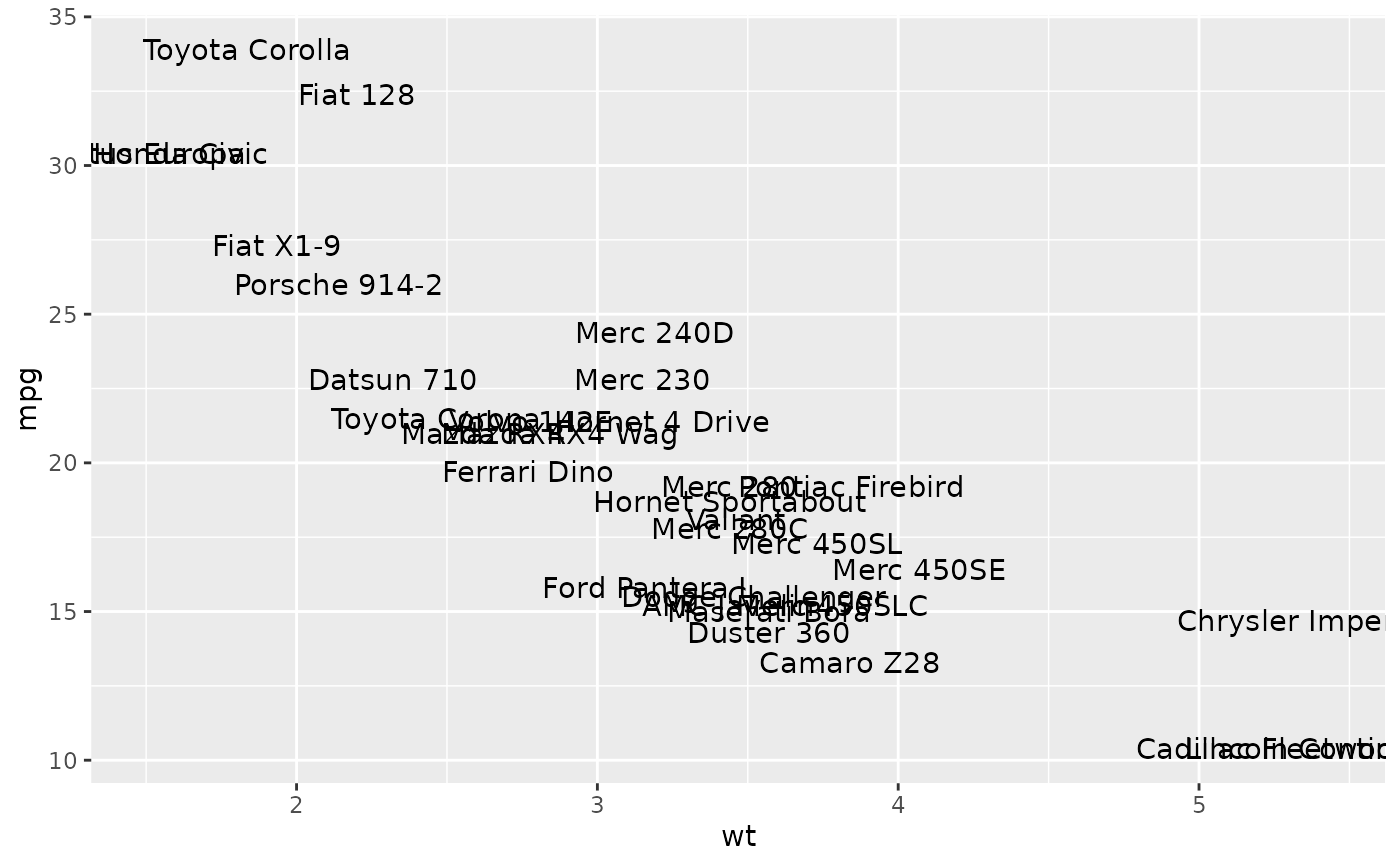 # Avoid overlaps
p + geom_text(check_overlap = TRUE)
# Avoid overlaps
p + geom_text(check_overlap = TRUE)
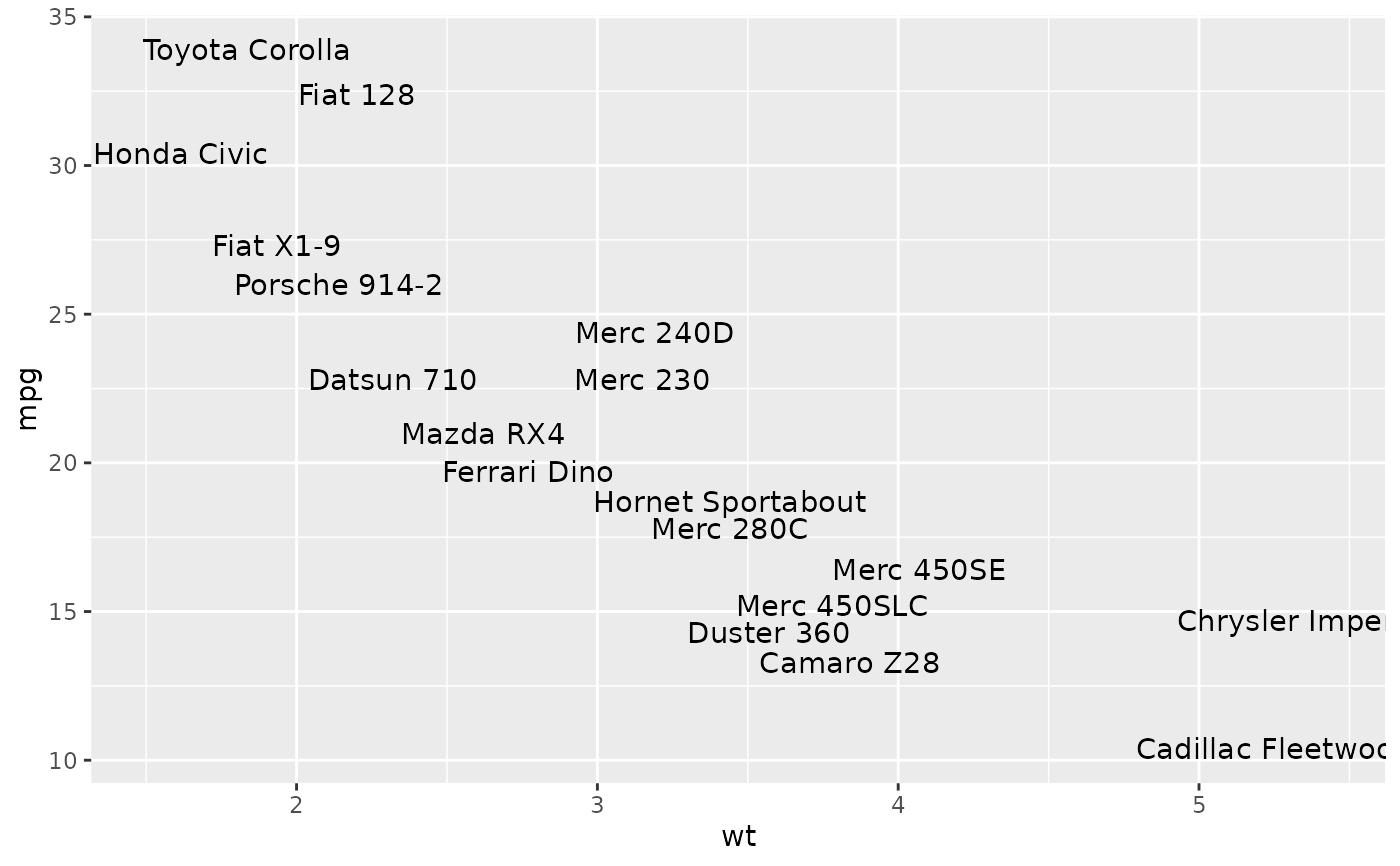 # Labels with background
p + geom_label()
# Labels with background
p + geom_label()
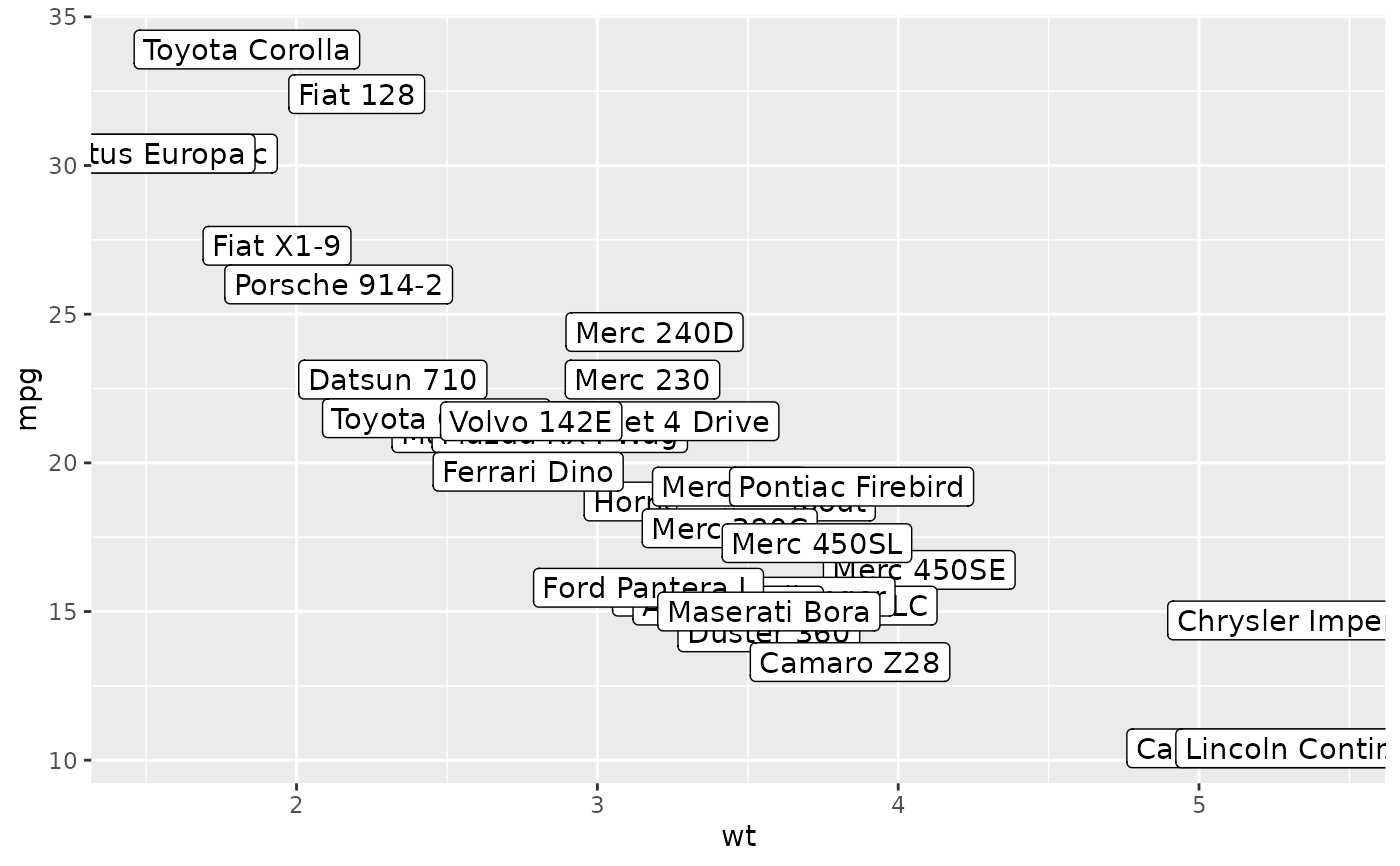 # Change size of the label
p + geom_text(size = 10)
# Change size of the label
p + geom_text(size = 10)
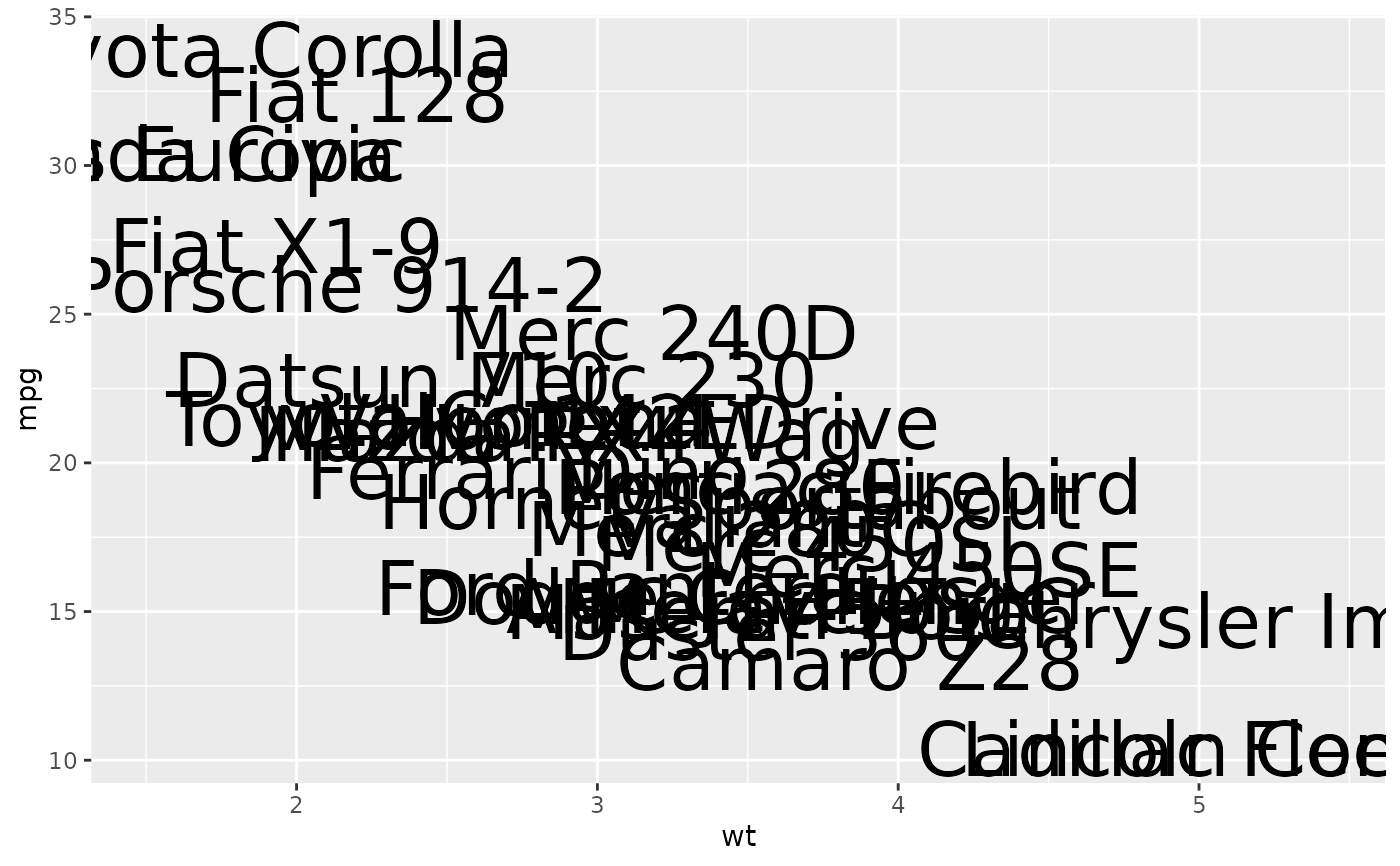 # Set aesthetics to fixed value
p +
geom_point() +
geom_text(hjust = 0, nudge_x = 0.05)
# Set aesthetics to fixed value
p +
geom_point() +
geom_text(hjust = 0, nudge_x = 0.05)
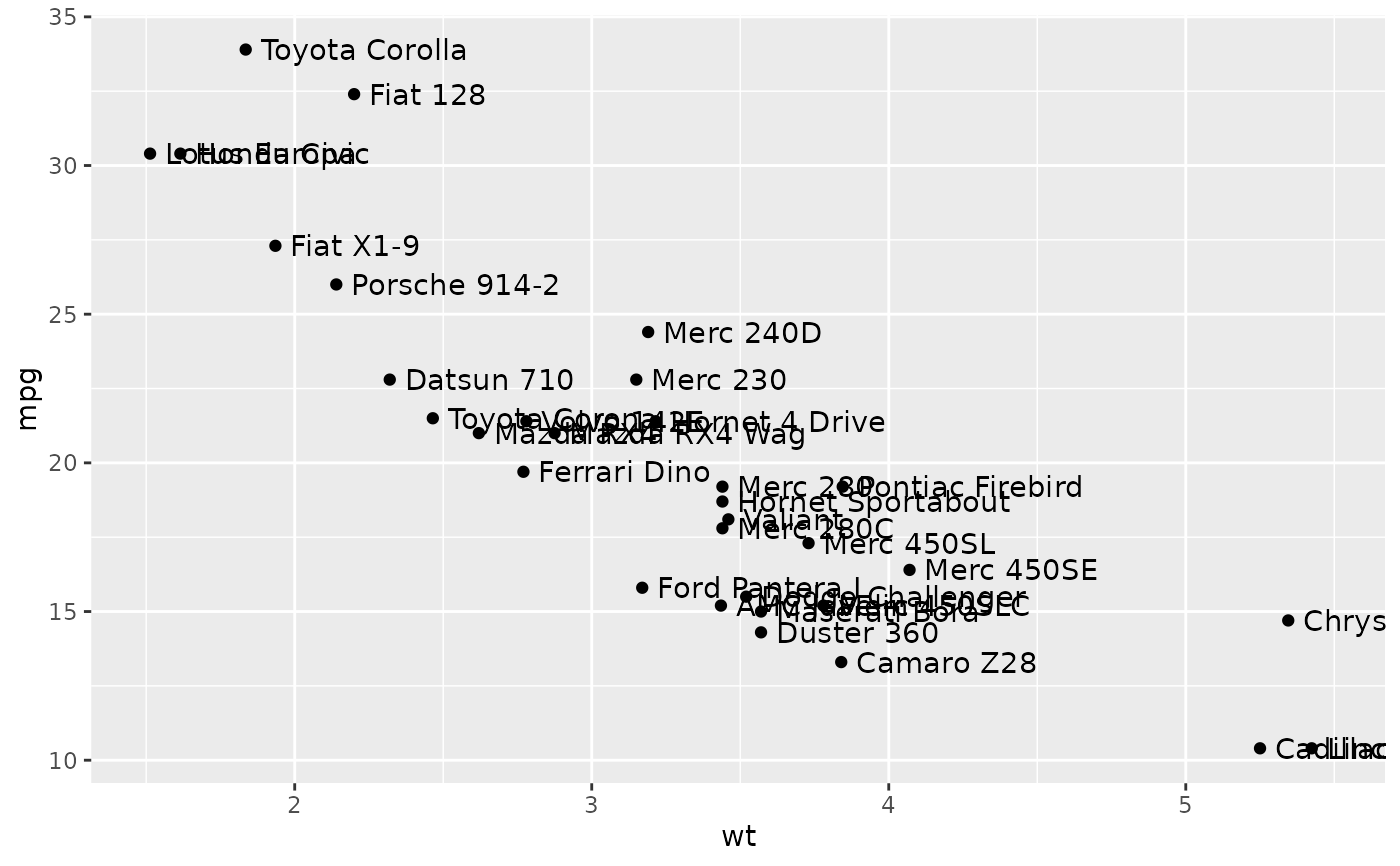 p +
geom_point() +
geom_text(vjust = 0, nudge_y = 0.5)
p +
geom_point() +
geom_text(vjust = 0, nudge_y = 0.5)
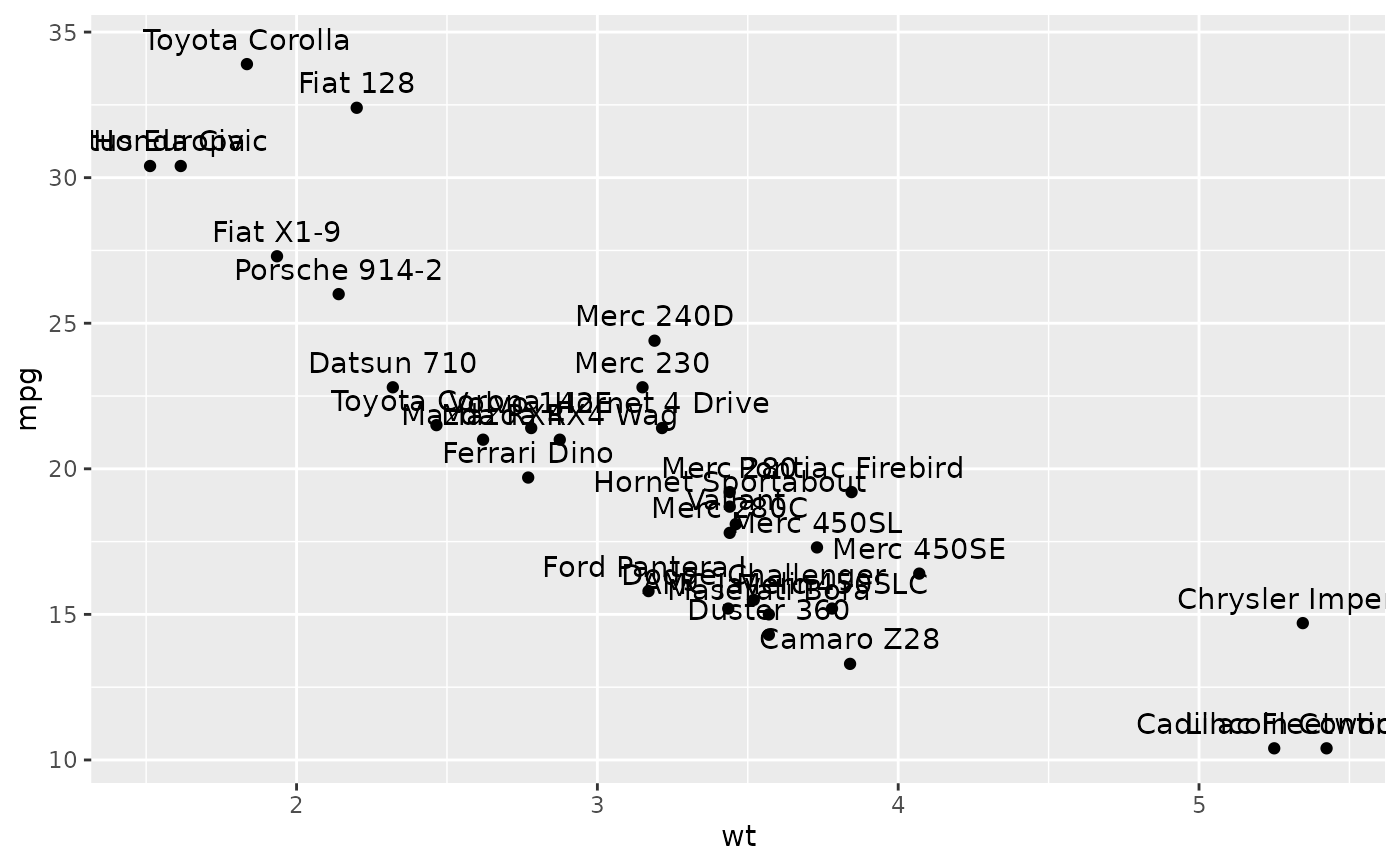 p +
geom_point() +
geom_text(angle = 45)
p +
geom_point() +
geom_text(angle = 45)
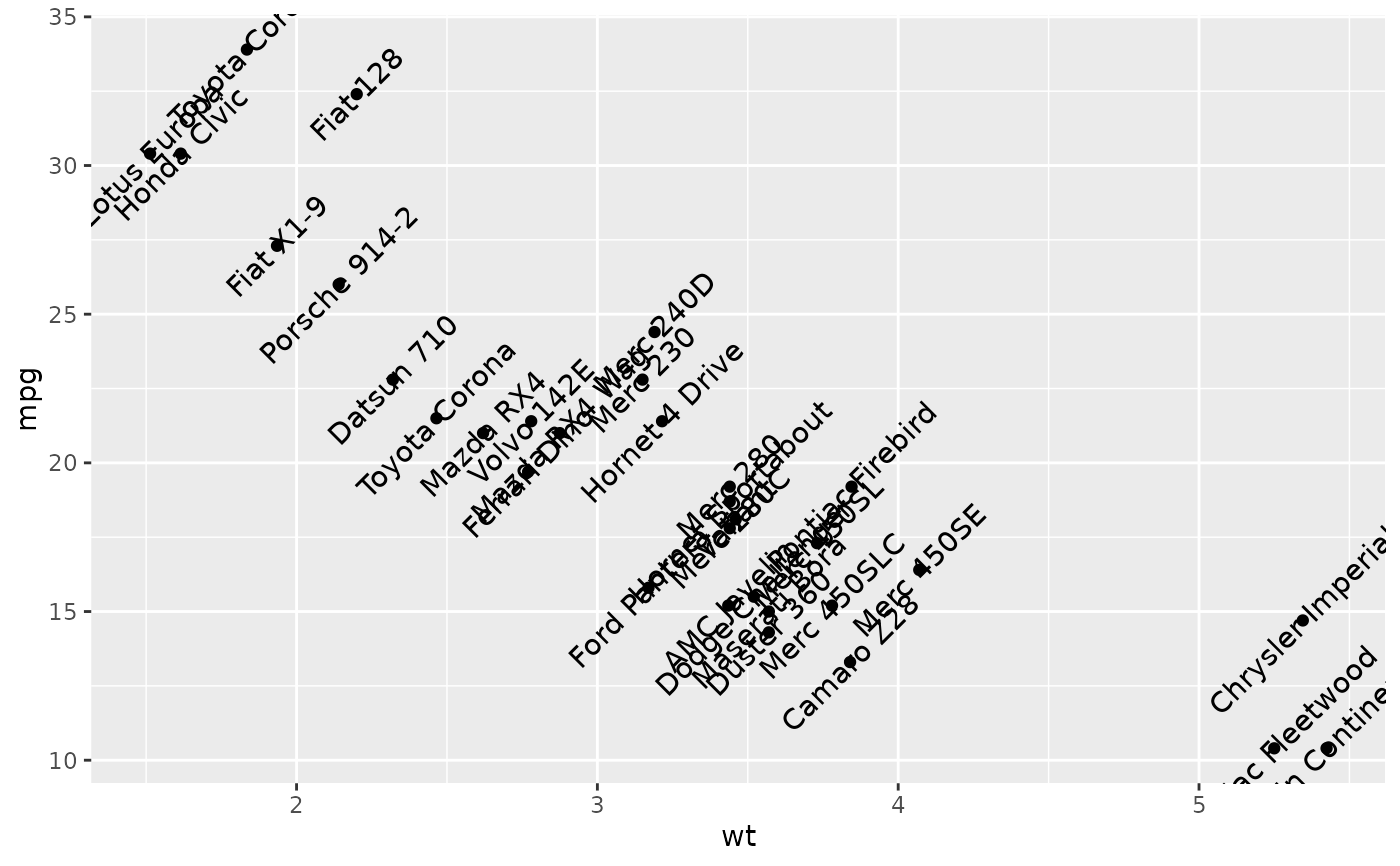 if (FALSE) { # \dontrun{
# Doesn't work on all systems
p +
geom_text(family = "Times New Roman")
} # }
# Add aesthetic mappings
p + geom_text(aes(colour = factor(cyl)))
if (FALSE) { # \dontrun{
# Doesn't work on all systems
p +
geom_text(family = "Times New Roman")
} # }
# Add aesthetic mappings
p + geom_text(aes(colour = factor(cyl)))
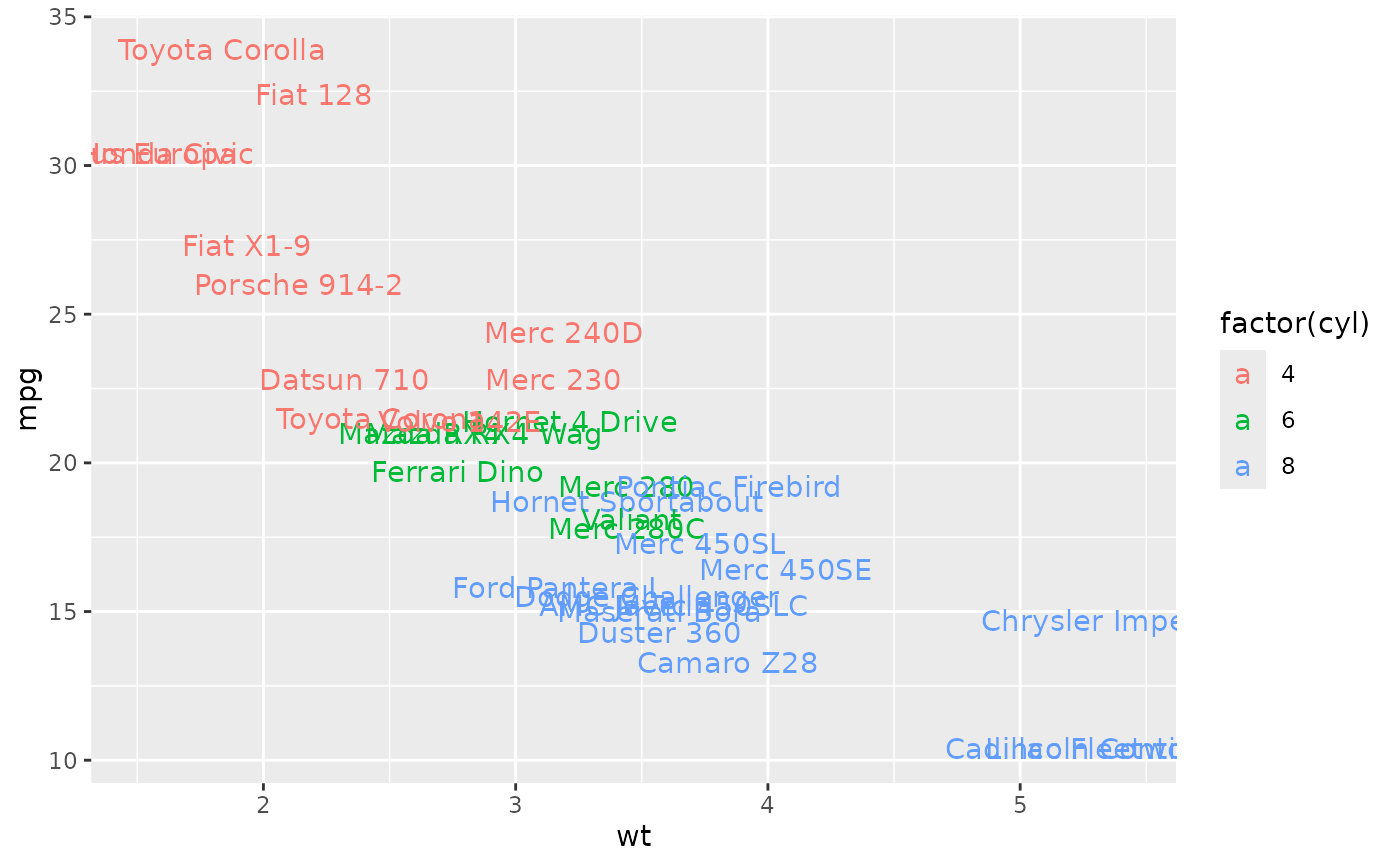 p + geom_text(aes(colour = factor(cyl))) +
scale_colour_hue(l = 40)
p + geom_text(aes(colour = factor(cyl))) +
scale_colour_hue(l = 40)
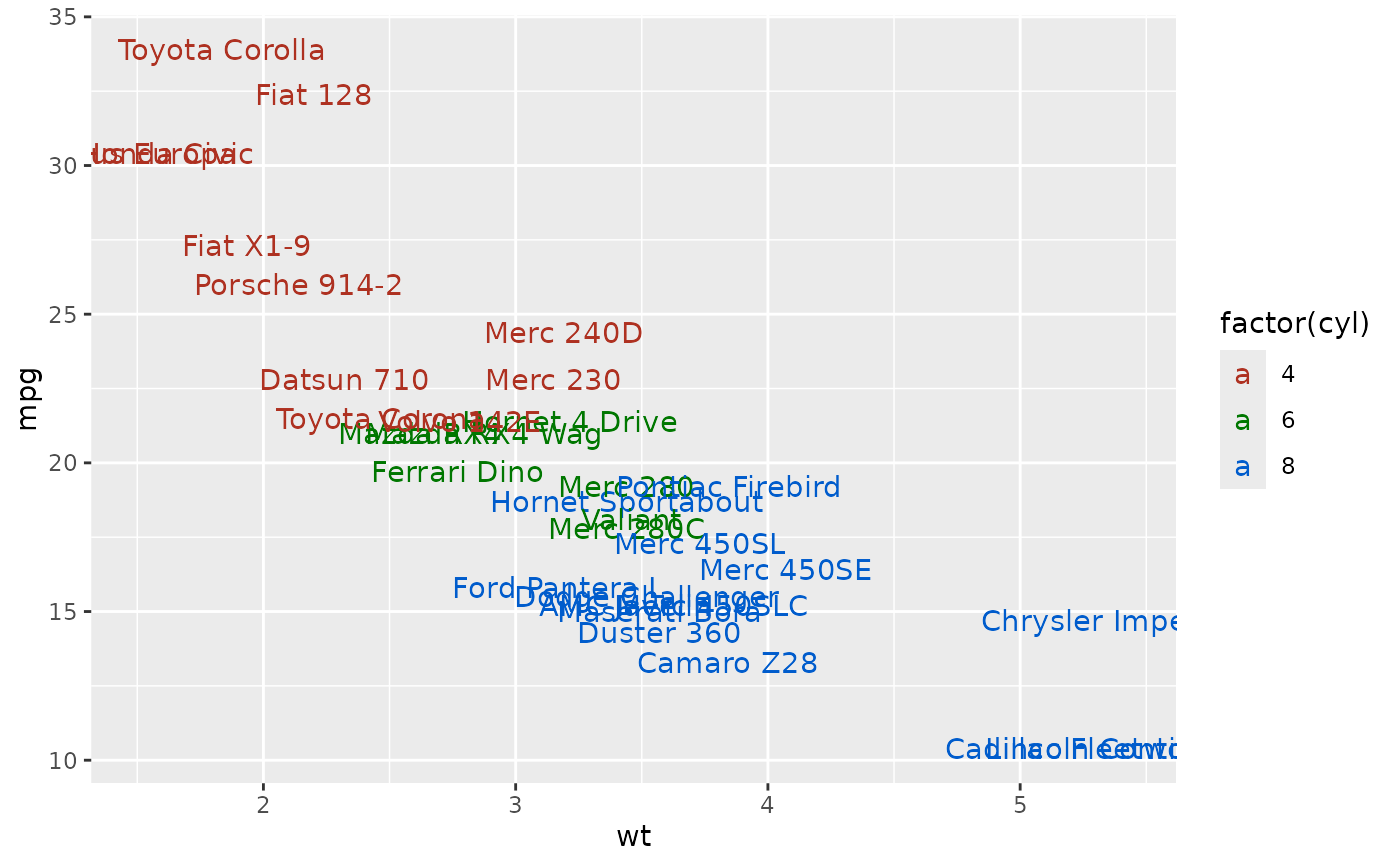 p + geom_label(aes(fill = factor(cyl)), colour = "white", fontface = "bold")
p + geom_label(aes(fill = factor(cyl)), colour = "white", fontface = "bold")
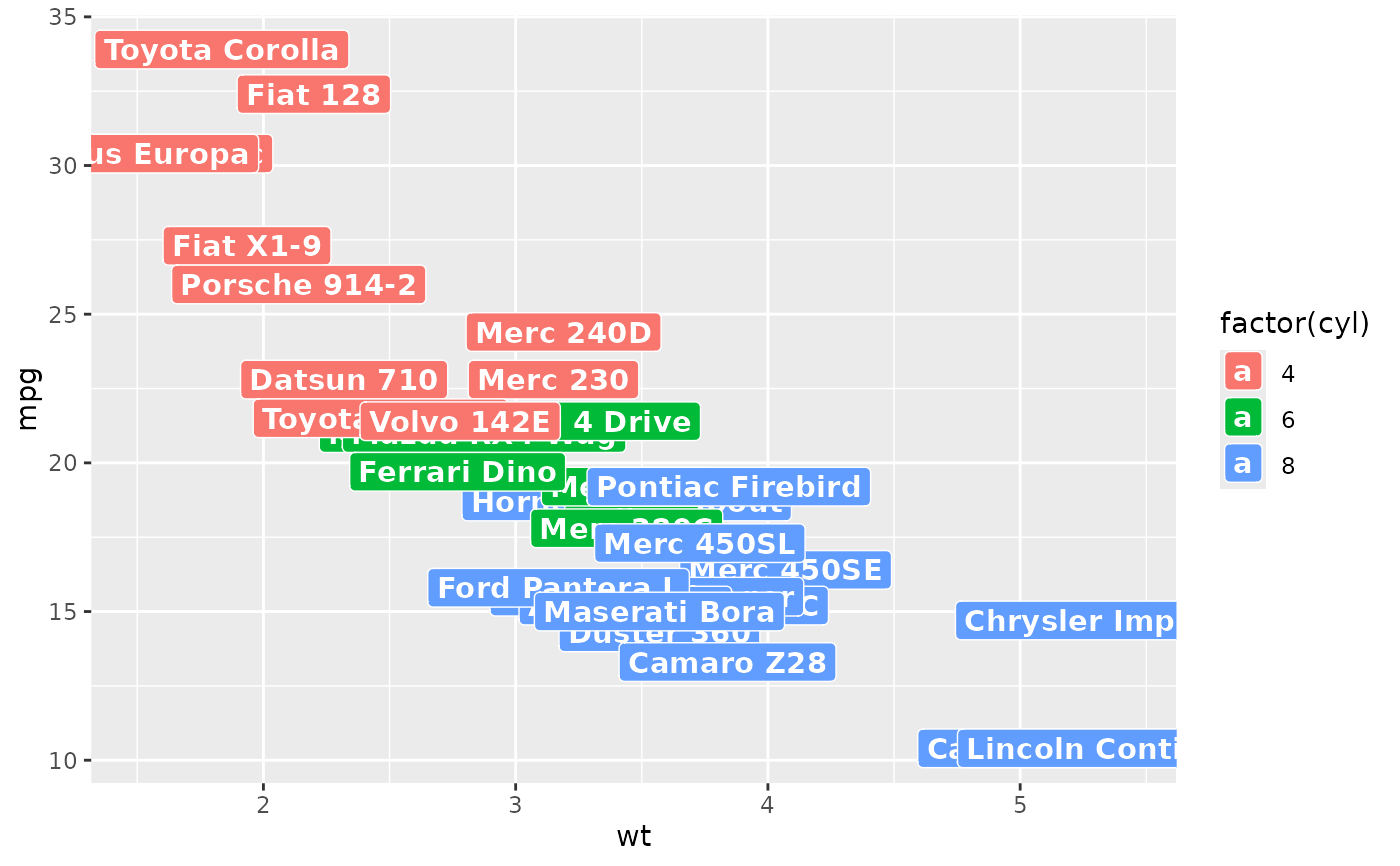 # Scale size of text, and change legend key glyph from a to point
p + geom_text(aes(size = wt), key_glyph = "point")
# Scale size of text, and change legend key glyph from a to point
p + geom_text(aes(size = wt), key_glyph = "point")
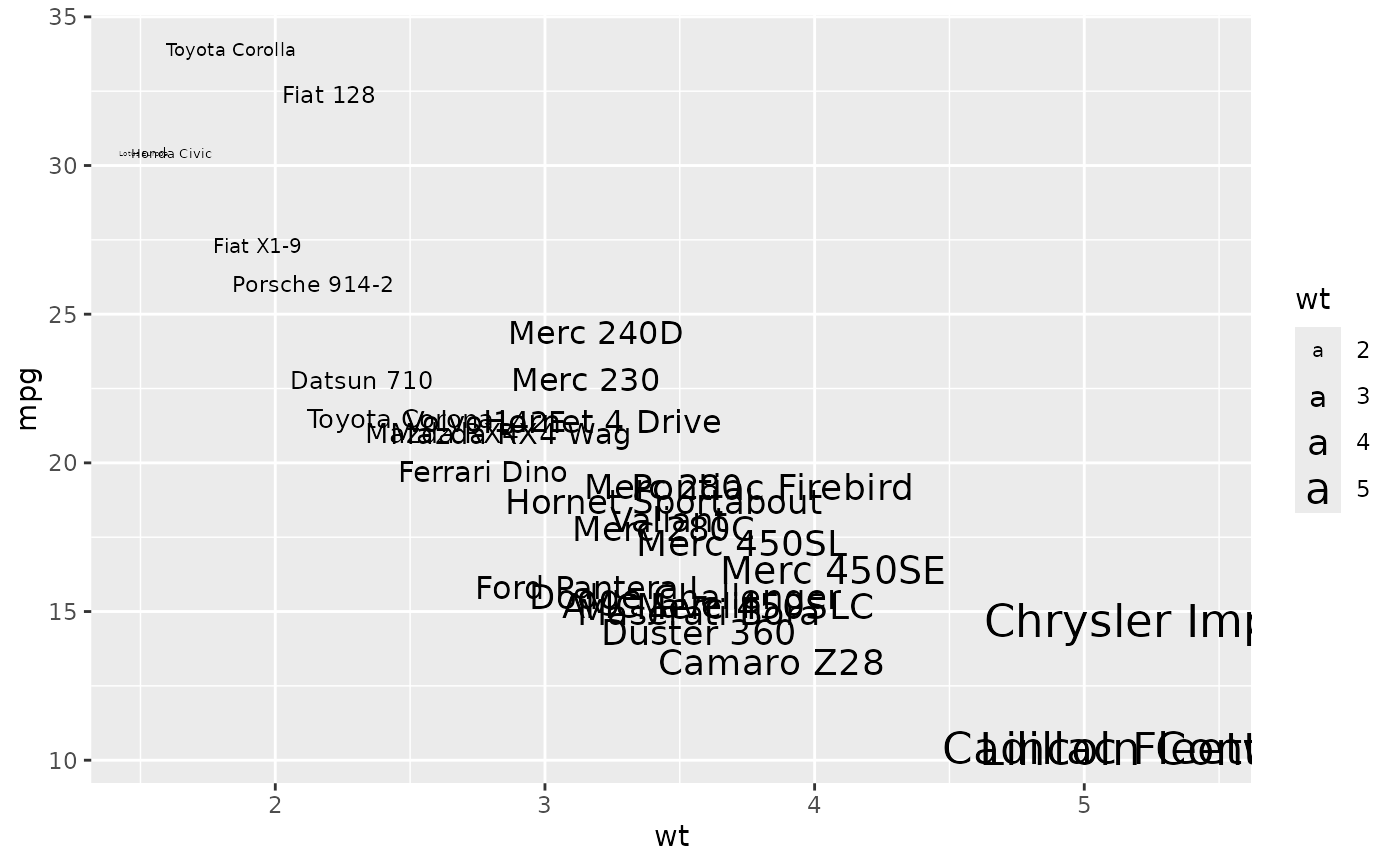 # Scale height of text, rather than sqrt(height)
p +
geom_text(aes(size = wt), key_glyph = "point") +
scale_radius(range = c(3,6))
# Scale height of text, rather than sqrt(height)
p +
geom_text(aes(size = wt), key_glyph = "point") +
scale_radius(range = c(3,6))
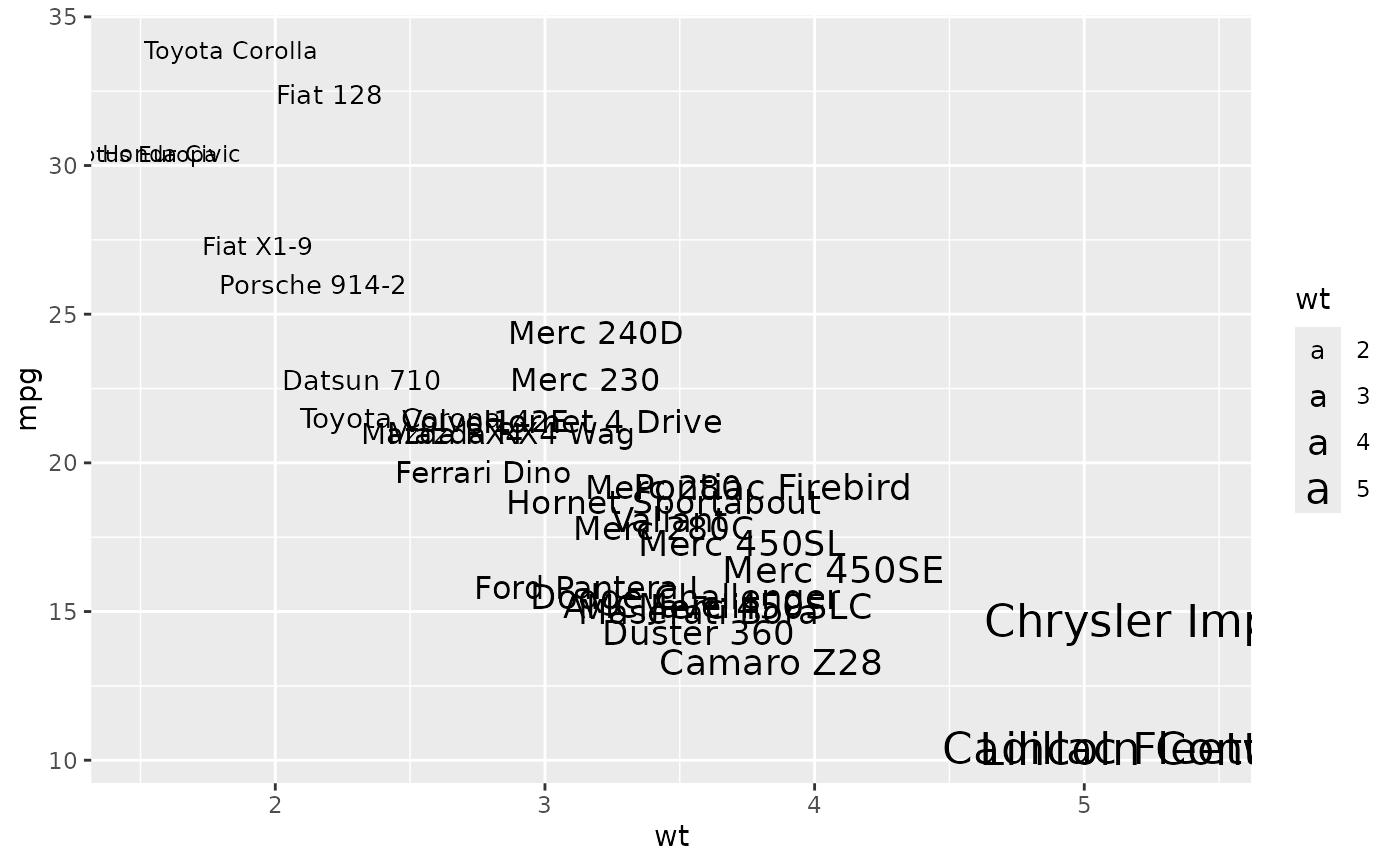 # You can display expressions by setting parse = TRUE. The
# details of the display are described in ?plotmath, but note that
# geom_text uses strings, not expressions.
p +
geom_text(
aes(label = paste(wt, "^(", cyl, ")", sep = "")),
parse = TRUE
)
# You can display expressions by setting parse = TRUE. The
# details of the display are described in ?plotmath, but note that
# geom_text uses strings, not expressions.
p +
geom_text(
aes(label = paste(wt, "^(", cyl, ")", sep = "")),
parse = TRUE
)
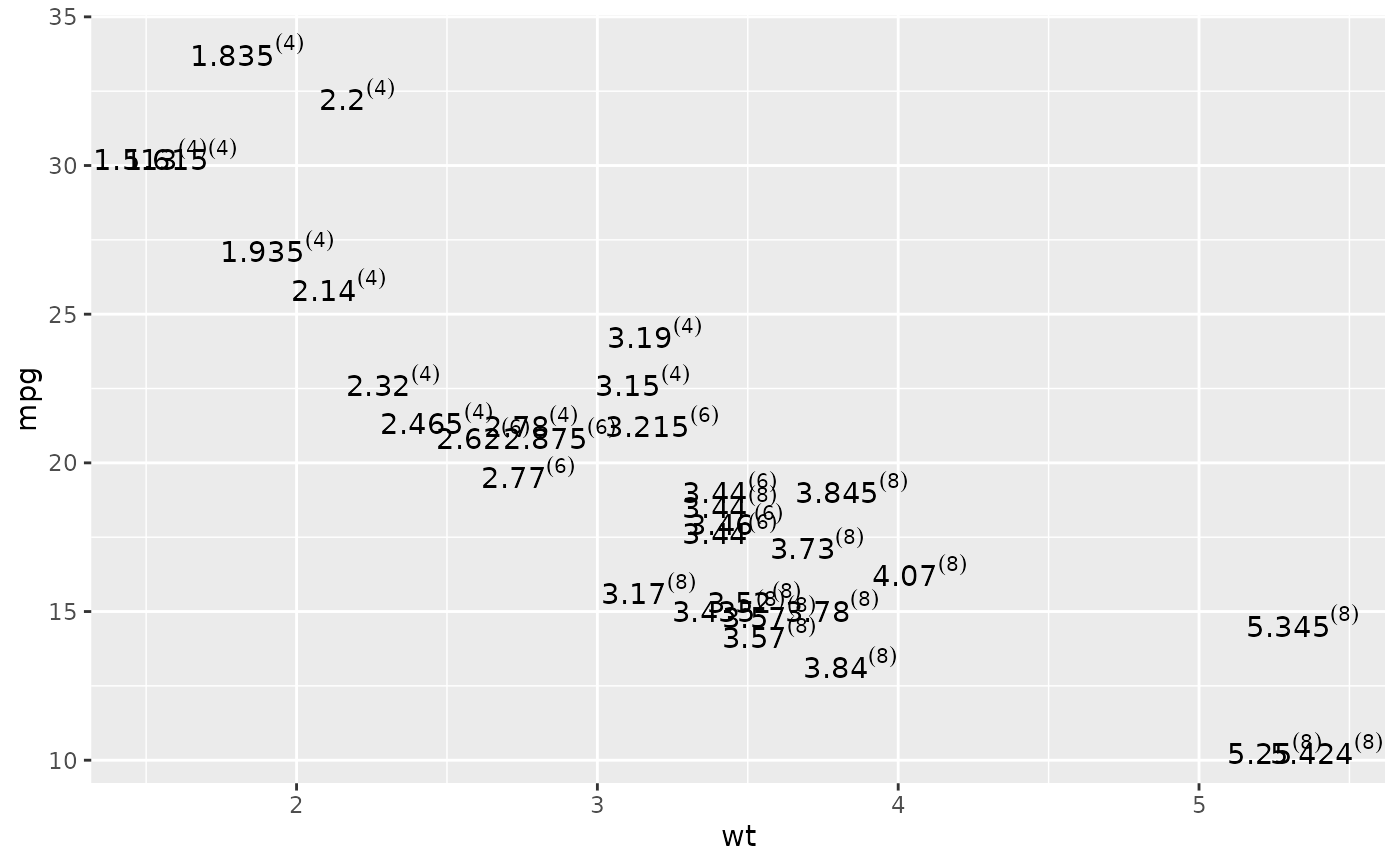 # Add a text annotation
p +
geom_text() +
annotate(
"text", label = "plot mpg vs. wt",
x = 2, y = 15, size = 8, colour = "red"
)
# Add a text annotation
p +
geom_text() +
annotate(
"text", label = "plot mpg vs. wt",
x = 2, y = 15, size = 8, colour = "red"
)
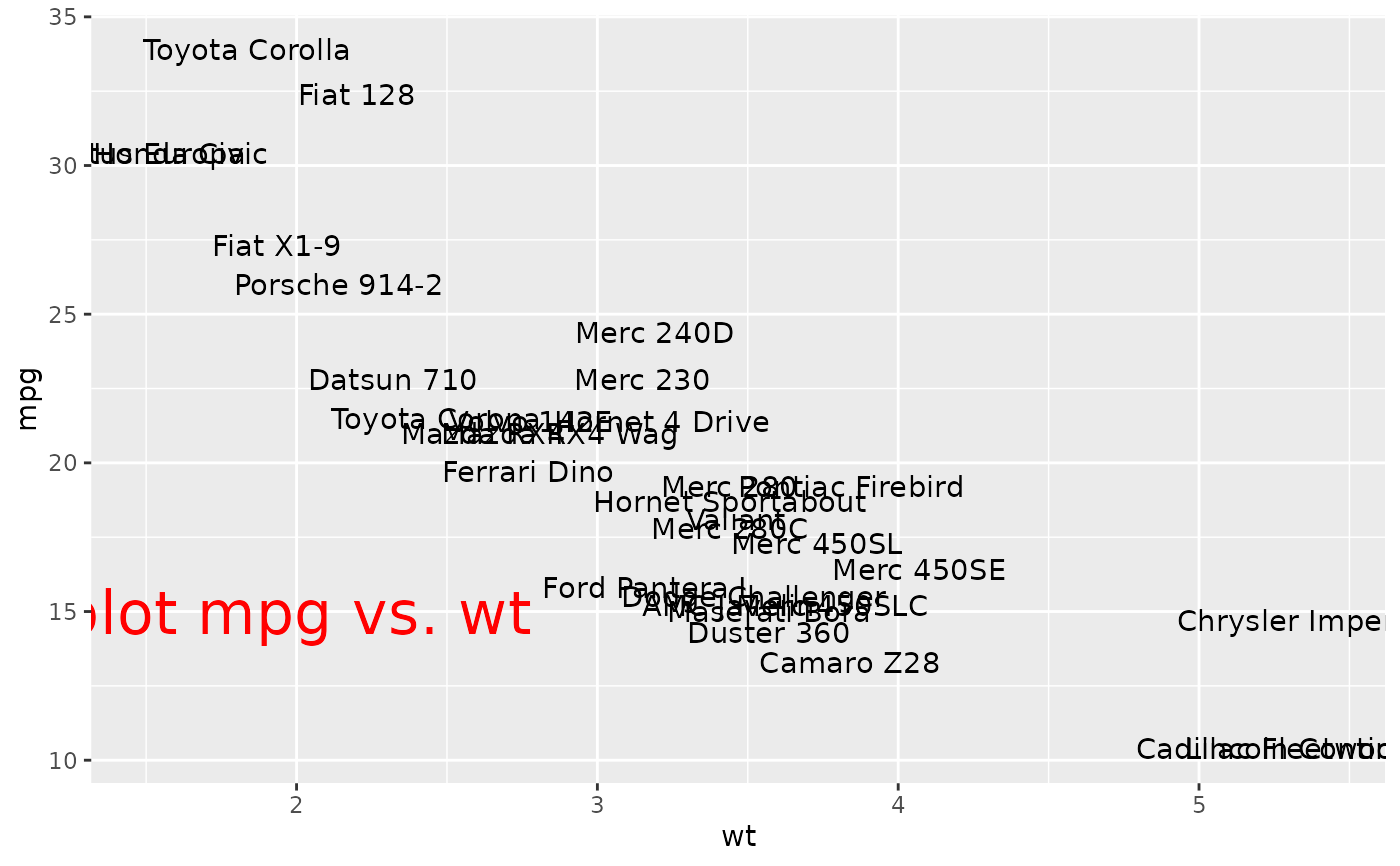 # \donttest{
# Aligning labels and bars --------------------------------------------------
df <- data.frame(
x = factor(c(1, 1, 2, 2)),
y = c(1, 3, 2, 1),
grp = c("a", "b", "a", "b")
)
# ggplot2 doesn't know you want to give the labels the same virtual width
# as the bars:
ggplot(data = df, aes(x, y, group = grp)) +
geom_col(aes(fill = grp), position = "dodge") +
geom_text(aes(label = y), position = "dodge")
#> Warning: Width not defined
#> ℹ Set with `position_dodge(width = ...)`
# \donttest{
# Aligning labels and bars --------------------------------------------------
df <- data.frame(
x = factor(c(1, 1, 2, 2)),
y = c(1, 3, 2, 1),
grp = c("a", "b", "a", "b")
)
# ggplot2 doesn't know you want to give the labels the same virtual width
# as the bars:
ggplot(data = df, aes(x, y, group = grp)) +
geom_col(aes(fill = grp), position = "dodge") +
geom_text(aes(label = y), position = "dodge")
#> Warning: Width not defined
#> ℹ Set with `position_dodge(width = ...)`
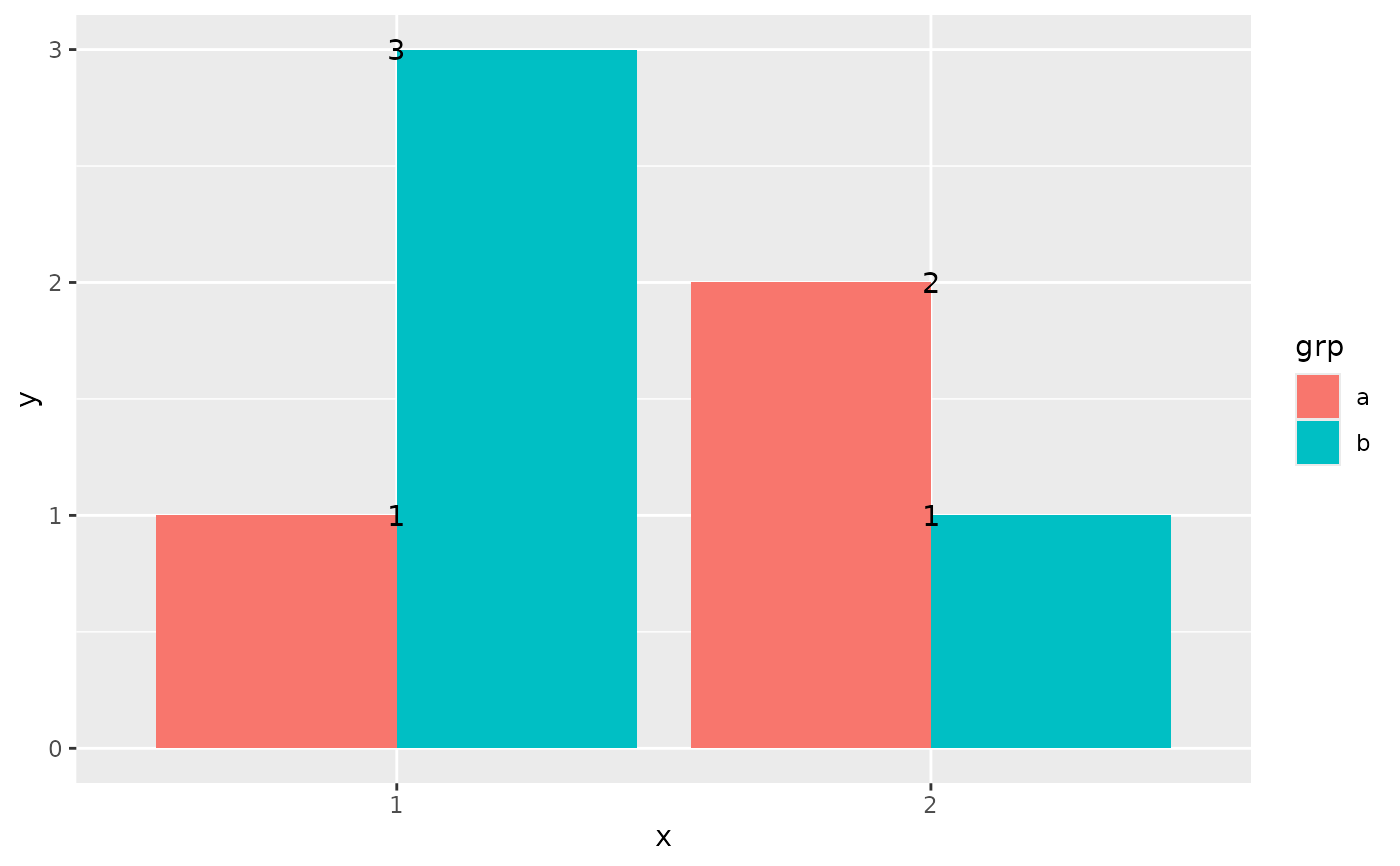 # So tell it:
ggplot(data = df, aes(x, y, group = grp)) +
geom_col(aes(fill = grp), position = "dodge") +
geom_text(aes(label = y), position = position_dodge(0.9))
# So tell it:
ggplot(data = df, aes(x, y, group = grp)) +
geom_col(aes(fill = grp), position = "dodge") +
geom_text(aes(label = y), position = position_dodge(0.9))
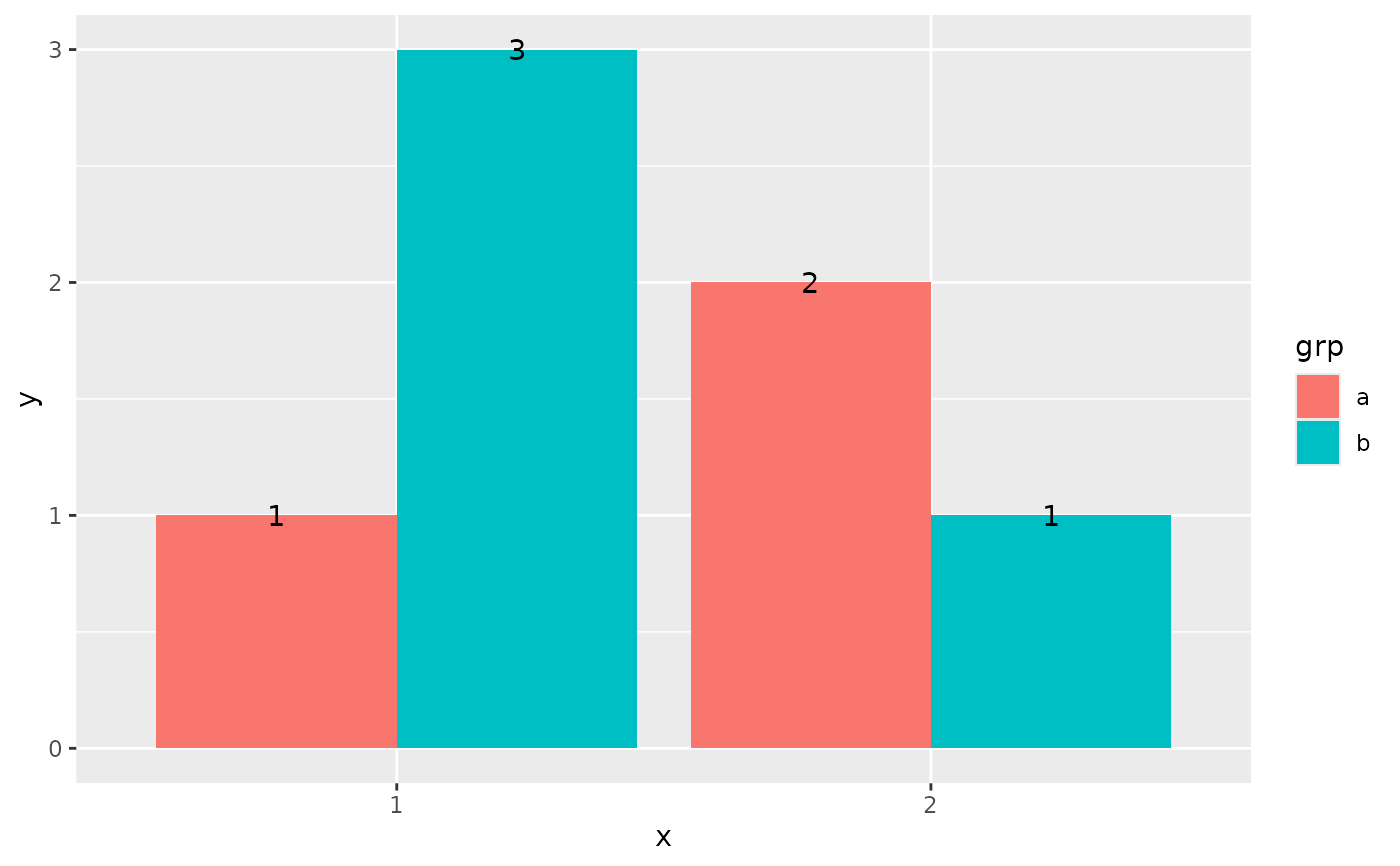 # You can't nudge and dodge text, so instead adjust the y position
ggplot(data = df, aes(x, y, group = grp)) +
geom_col(aes(fill = grp), position = "dodge") +
geom_text(
aes(label = y, y = y + 0.05),
position = position_dodge(0.9),
vjust = 0
)
# You can't nudge and dodge text, so instead adjust the y position
ggplot(data = df, aes(x, y, group = grp)) +
geom_col(aes(fill = grp), position = "dodge") +
geom_text(
aes(label = y, y = y + 0.05),
position = position_dodge(0.9),
vjust = 0
)
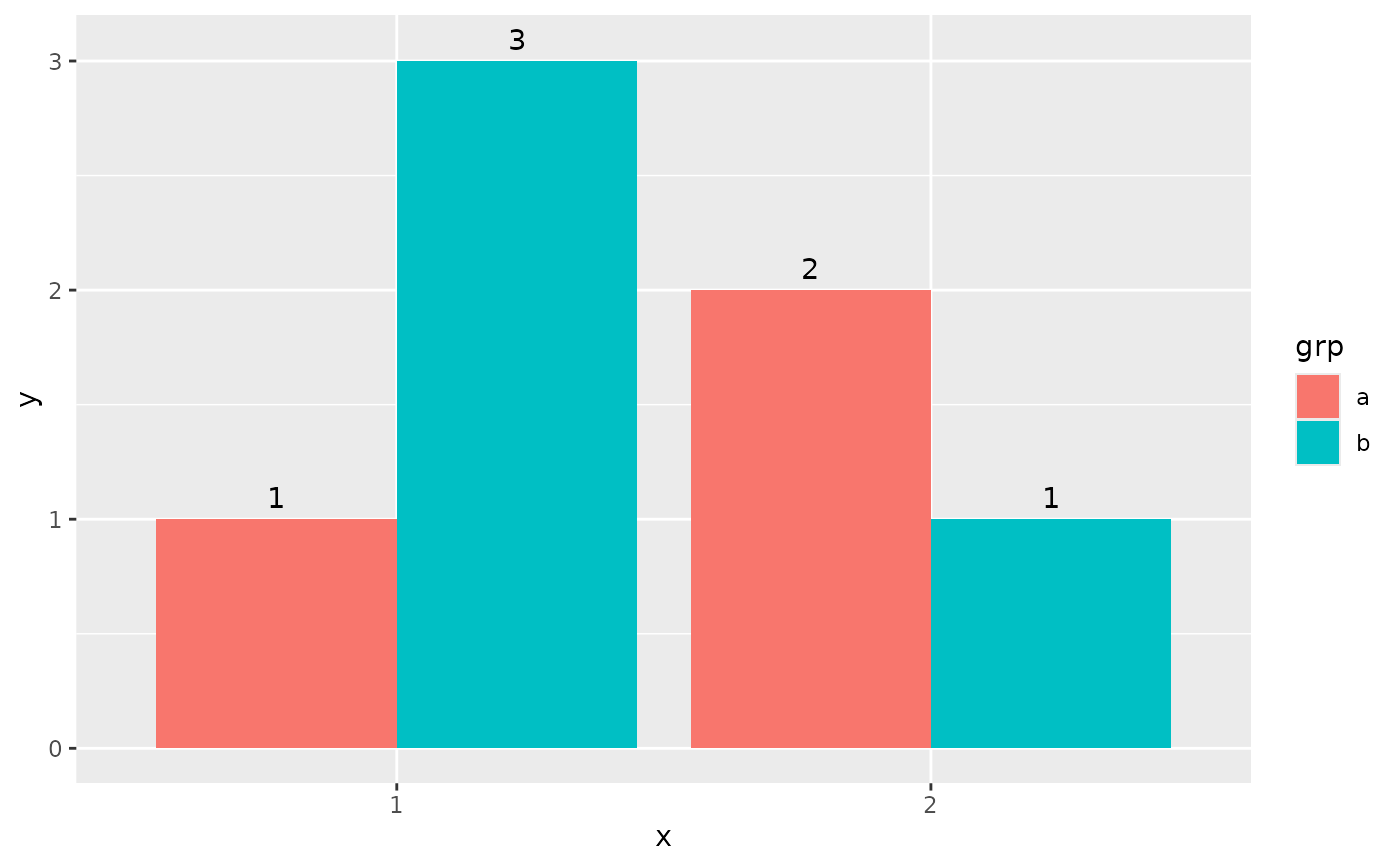 # To place text in the middle of each bar in a stacked barplot, you
# need to set the vjust parameter of position_stack()
ggplot(data = df, aes(x, y, group = grp)) +
geom_col(aes(fill = grp)) +
geom_text(aes(label = y), position = position_stack(vjust = 0.5))
# To place text in the middle of each bar in a stacked barplot, you
# need to set the vjust parameter of position_stack()
ggplot(data = df, aes(x, y, group = grp)) +
geom_col(aes(fill = grp)) +
geom_text(aes(label = y), position = position_stack(vjust = 0.5))
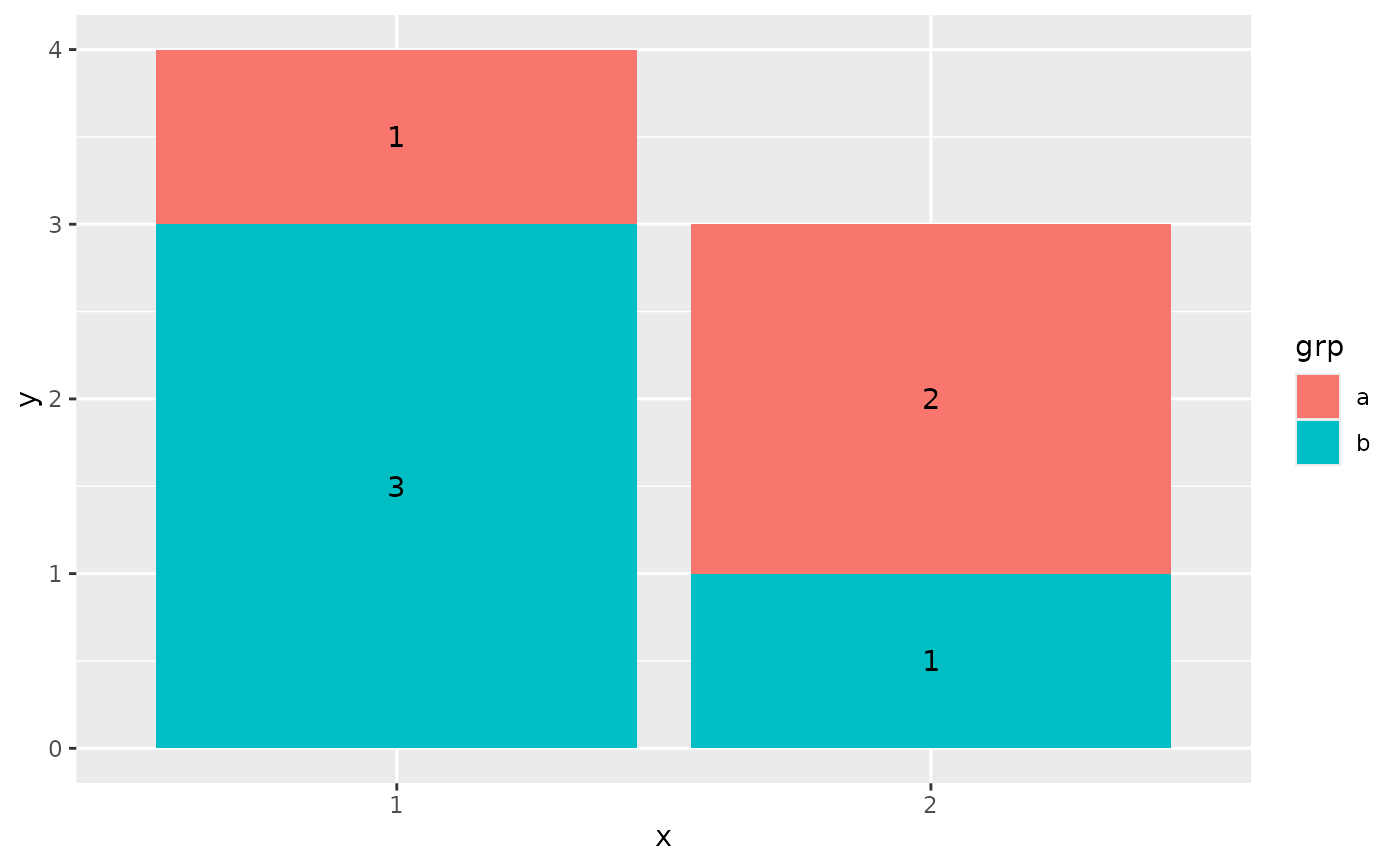 # Justification -------------------------------------------------------------
df <- data.frame(
x = c(1, 1, 2, 2, 1.5),
y = c(1, 2, 1, 2, 1.5),
text = c("bottom-left", "top-left", "bottom-right", "top-right", "center")
)
ggplot(df, aes(x, y)) +
geom_text(aes(label = text))
# Justification -------------------------------------------------------------
df <- data.frame(
x = c(1, 1, 2, 2, 1.5),
y = c(1, 2, 1, 2, 1.5),
text = c("bottom-left", "top-left", "bottom-right", "top-right", "center")
)
ggplot(df, aes(x, y)) +
geom_text(aes(label = text))
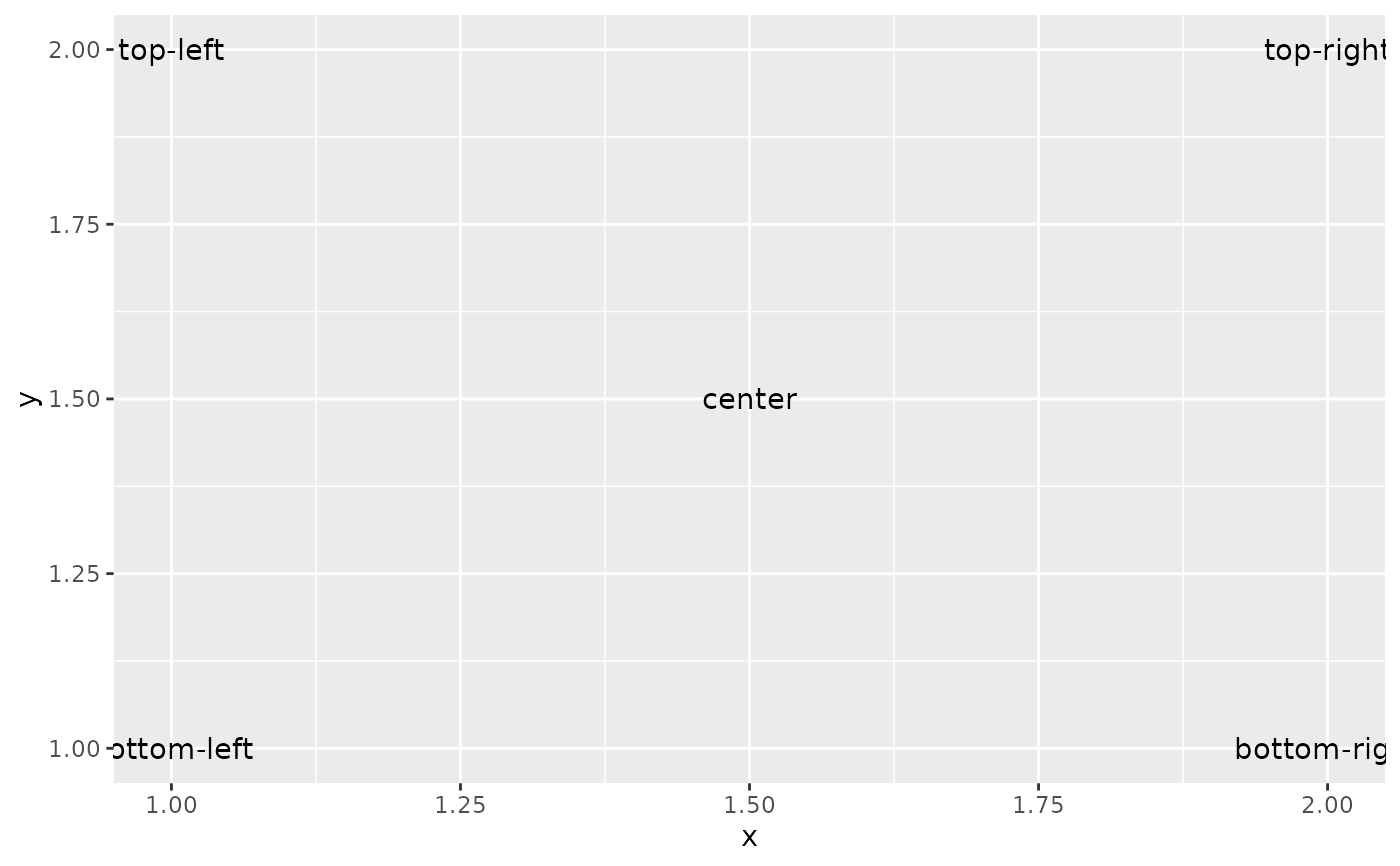 ggplot(df, aes(x, y)) +
geom_text(aes(label = text), vjust = "inward", hjust = "inward")
ggplot(df, aes(x, y)) +
geom_text(aes(label = text), vjust = "inward", hjust = "inward")
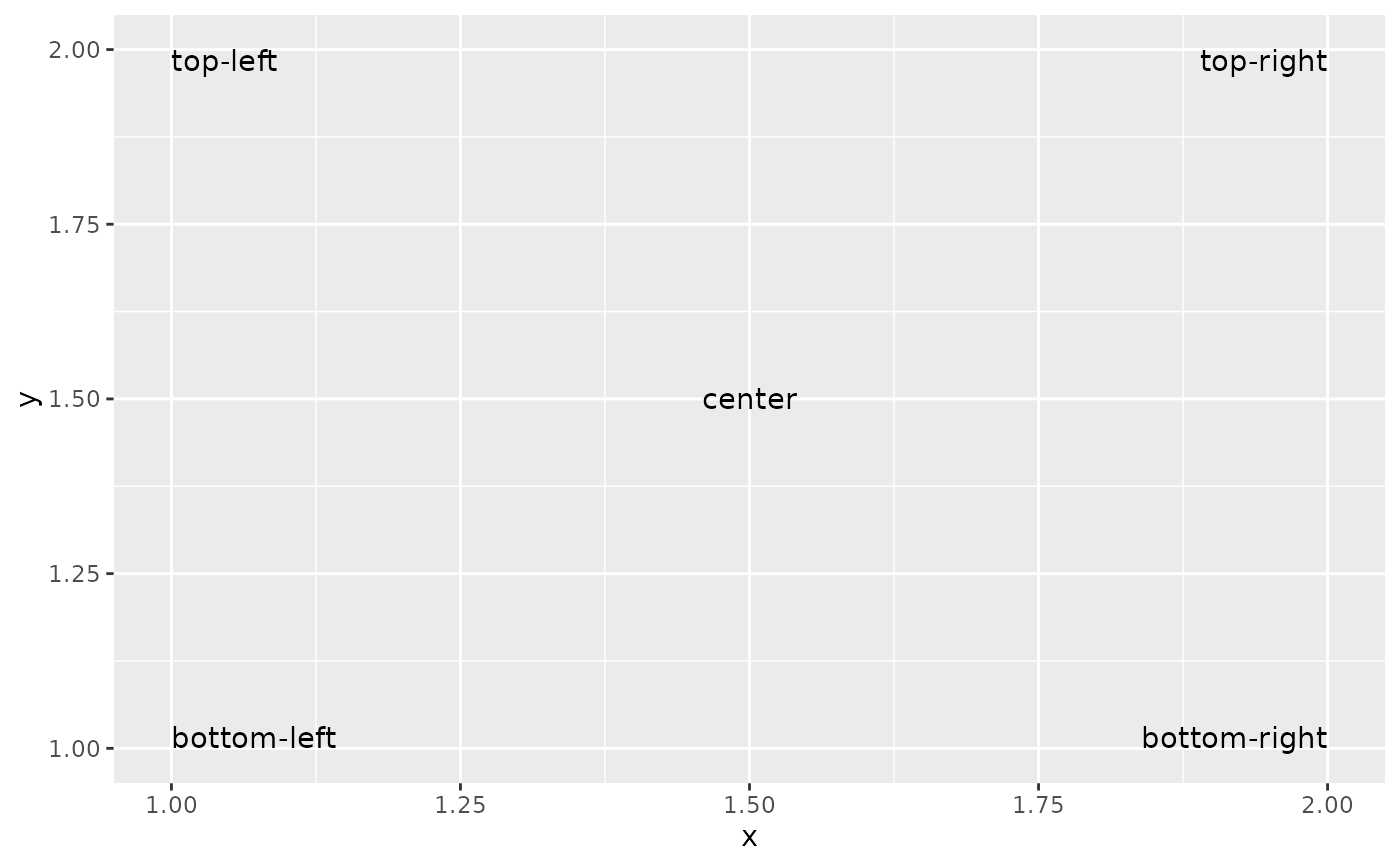 # }
# }
